Ski report from Kebnekaise, April '99
If you want the background to these stories, see the introduction.
Photographs are included in this text, but if you prefer you
can look at the photos separately in the gallery.
The plan for this year was for 4 days of top tours from Kebnekaise fjaellstation,
before joining friends for another winter camping trip in Norway, but after
2 days my hands swelled up horribly, and I aborted the rest of the trip to
let my tendons recover properly. I'll briefly report on those 2 days, mostly
out of habit, but also because some fellow novice might benefit from my
observations on the transition from tour to telemark skis. If you want to know
more about Kebnekaise, and reaching the south peak, see the report from
my '97 attempt.
To the horror of my purist friends, I again took the caterpillar transport
from Nikkaluokta to Kebnekaise fjaellstation. The journey is across 18km of lake and
almost flat forest, 'almost' in that all the motorised transport has caused half-metre
moguls to develop. After a bad night in a busy sleeping carriage, the choice
between dragging a sled for 5 hours over such terrain, or a quick transport and
some hours warming up on the beautiful slopes around Kebnekaise with a minimal
pack, was an easy one for me. To lower my credibility to further, for the
price of a bottle of beer I upgraded from a dorm with 20 or more beds in the
old quarters, to a double room in an adjacent building. But I drew the line at
eating in the restaurant, and cooked in the communal kitchen.
The last week in March, a week before Easter, was still low season,
so I had the room to myself, which I appreciated greatly, and awoke ready
for an adventure.
The weather was dull, around zero, cloudy and windless, but the forecast
suggested worse coming, so bagging the south peak wasn't looking hopeful for this trip.
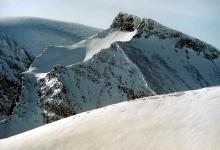 Ideally, I would have done something gentle this first day, but with the
probability of best visibility being for that day, I decided to climb
Tolpagorni,
the impressive cratered peak that looms behind the fjaellstation. It is 500m
lower than the south peak of Kebnekaise, but still a good climb of 900m from the station.
With few other people around and the dodgy weather, I couldn't count on
having company nearby, and so packed 10kg of emergency overnight kit in case
'something happened'. Snow conditions were odd. There had been little snow all season,
and a thaw, so there was a lot of hard ice and exposed rocks, but a couple of
days previously there had been heavy snow fall and wind, so on lee slopes
the avalanche hazard was high. Any surface snow was soft in the humid mildness.
Ideally, I would have done something gentle this first day, but with the
probability of best visibility being for that day, I decided to climb
Tolpagorni,
the impressive cratered peak that looms behind the fjaellstation. It is 500m
lower than the south peak of Kebnekaise, but still a good climb of 900m from the station.
With few other people around and the dodgy weather, I couldn't count on
having company nearby, and so packed 10kg of emergency overnight kit in case
'something happened'. Snow conditions were odd. There had been little snow all season,
and a thaw, so there was a lot of hard ice and exposed rocks, but a couple of
days previously there had been heavy snow fall and wind, so on lee slopes
the avalanche hazard was high. Any surface snow was soft in the humid mildness.
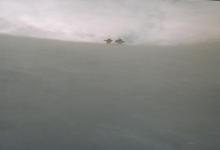 To compound the difficulties, I was experimenting with new skis - Tua Cirque,
a go-anywhere tour/telemark hybrid that I had had great success with
on prepared pistes, and now wanted to try on loose snow. But having a
pronounced waist, they were not inclined to track straight, and having no
centre groove, they had a tendency to dive sidways into the snow.
In addition, their soft camber caused them to lose wax quickly and slip backwards.
All this meant that the easy 3km run to the bottom of Kittelbäcken
was much more of a struggle than it should have been, and took about an hour.
I suppose the Tuas are the Landrovers of the skiing world - they will go anywhere,
but if you're on a motorway you'd probably rather be in a Ford.
Once I'd put on my climbing skins, clicked up my Televator heel supports,
and started climbing Kittelbäcken, they were in their element and
I was happy again, and looking forward to coming
back down the loose snow in the ravine. The wind was rapidly picking up,
and by the time I got up to Björling's glacier it was probably around 15 m/s.
Ahead of me I was glad to see two teams headed for the south peak,
a group of 5 Norwegian girls just ahead, and 3 Swedish guys. For a while I considered
following them, but it was my first day touring for a year,
and the weather wasn't good, so I contented myself with my decision to go
left to Tolpagorni at the saddle, rather than going right, up to Vierranvarri
then 500m down and 700m back up to the south peak. And back.
To compound the difficulties, I was experimenting with new skis - Tua Cirque,
a go-anywhere tour/telemark hybrid that I had had great success with
on prepared pistes, and now wanted to try on loose snow. But having a
pronounced waist, they were not inclined to track straight, and having no
centre groove, they had a tendency to dive sidways into the snow.
In addition, their soft camber caused them to lose wax quickly and slip backwards.
All this meant that the easy 3km run to the bottom of Kittelbäcken
was much more of a struggle than it should have been, and took about an hour.
I suppose the Tuas are the Landrovers of the skiing world - they will go anywhere,
but if you're on a motorway you'd probably rather be in a Ford.
Once I'd put on my climbing skins, clicked up my Televator heel supports,
and started climbing Kittelbäcken, they were in their element and
I was happy again, and looking forward to coming
back down the loose snow in the ravine. The wind was rapidly picking up,
and by the time I got up to Björling's glacier it was probably around 15 m/s.
Ahead of me I was glad to see two teams headed for the south peak,
a group of 5 Norwegian girls just ahead, and 3 Swedish guys. For a while I considered
following them, but it was my first day touring for a year,
and the weather wasn't good, so I contented myself with my decision to go
left to Tolpagorni at the saddle, rather than going right, up to Vierranvarri
then 500m down and 700m back up to the south peak. And back.
The kilometer from the glacier up to the saddle slopes at about 30°,
climbable directly on skins in perfect conditions, but with 5cm damp loose snow over ice,
alternating with hard windslab, I had to traverse, and when I lost an edge
I slid rapidly sideways, sometimes losing a hard-won-back metre of height.
Eventually I gave up skiing, strapped my skis to my pack and pulled out
the light walking crampons that I'd picked up for next to nothing in a
second-hand shop, unsure that they would ever be useful.
They were. Able to walk straight up the hill where the Norwegians were
post-holing traverses, I almost caught them up, and being able to adjust my poles
down to 110cm made life a lot easier too.
At the saddle I had lunch in my wind sack,
but here there was no snow at all, just a centimetre or so of icy windslab,
so I couldn't make supports with my skis or poles, and just let the sack
billow around me in the gale.
I then left my skis wedged between some rocks and hiked the 200 vertical metres
to Tolpagorni's peak using my crampons and poles. Almost at the top clouds
started to blow in, and I realised that although I would have little trouble
navigating back down in fog, finding my skis could take a long time, so I quickly
took a compass fix on them before they disappeared into greyness, and hoped that I could
dead-reckon back to them if the fog persisted. Meanwhile, I considered the
dangers of admiring the view from my peak. The wind was gusting hard from behind,
so being blown over the edge wasn't impossible. There were cornices over
the crater which could break, and the huge accumulation of snow in the basin
was just longing to avalanche, should I fall into it. I found the fixed rope
that better skiers than I use to lower themselves into the crater for some exclusive
first tracks, and wrapped it around my arm before approaching the edge,
probing for rock. I needn't have bothered with all this,
as the plumes of snow being blown over the top obscured what must otherwise
be an excellent view up and down Ladtjovagge.
The cloud passed, so I found my skis easily, but found that the
transitions from loose snow to windslab were too frequent for me to telemark
down as I'd hoped, but I still appreciated the stability and manoverability of
my waisted skis and high boots. I was also grateful that I had mounted Voile
release bindings, as I caught an inside edge on a small sastruga and my ski twisted outwards, sending a sharp pain through my knee just as the
binding released. It seemed fairly clear that I would have torn something
useful in my leg if I'd had conventional bindings.
A more minor modification I'd made was to cover my binding plates
with parcel tape to prevent snow sticking and building up to ice wedges,
which I usually have to hack off when they become so thick that they stop my foot
coming down enough, and this had worked well.
I was exhausted when I arrived back, more than I felt I deserved, and hoped for
more stamina for my next day. I heard that 3 groups had turned back before
reaching the south peak that day.
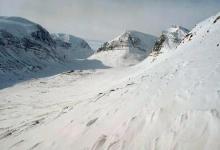 The next day was completely still, sunny, and -2°C, a perfect day for
a top tour, but I decided to stick to my plans for an easy day heading up to Tarfala.
But not to make it too easy, I chose to go up over the top of Kebnetjåkka
and then take the conventional route back down Tarfalajåkk.
It was 2 hours of pleasant skinning up Personalbacken to the plateau,
with an excellent view of my previous day's trek to Tolpagorni.
The next day was completely still, sunny, and -2°C, a perfect day for
a top tour, but I decided to stick to my plans for an easy day heading up to Tarfala.
But not to make it too easy, I chose to go up over the top of Kebnetjåkka
and then take the conventional route back down Tarfalajåkk.
It was 2 hours of pleasant skinning up Personalbacken to the plateau,
with an excellent view of my previous day's trek to Tolpagorni.
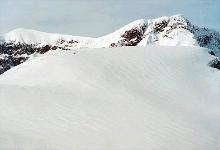 I wandered around the plateau for a while, enjoying the view of Kebnekaise's
north and south peaks, and the glaciers flowing down to Tarfala,
and went over to the western edge to look down on
Björling's glacier, before heading for Rännan, the skiable slope
in the north-east corner that takes one down between ravines to Tarfalajåkk.
I'd been told that it sloped around 20-25°, and should have developed
excellent telemarking conditions during the westerly snowfall. What I found
was a rocky ice field sloping 30-35°, so my first thought was that I was
between the wrong ravines, but bearings on some obvious landmarks and the
1:20000 map told otherwise.
I had climbed an extra 700m for the pleasure of side-slipping, walking, and
falling back down again. I wasn't happy. It was then a long hour's trek
on a slight traverse over uneven windslab to the STF cabin, past the glacier
research station famous for receiving the strongest winds ever recorded in
Sweden.
I wandered around the plateau for a while, enjoying the view of Kebnekaise's
north and south peaks, and the glaciers flowing down to Tarfala,
and went over to the western edge to look down on
Björling's glacier, before heading for Rännan, the skiable slope
in the north-east corner that takes one down between ravines to Tarfalajåkk.
I'd been told that it sloped around 20-25°, and should have developed
excellent telemarking conditions during the westerly snowfall. What I found
was a rocky ice field sloping 30-35°, so my first thought was that I was
between the wrong ravines, but bearings on some obvious landmarks and the
1:20000 map told otherwise.
I had climbed an extra 700m for the pleasure of side-slipping, walking, and
falling back down again. I wasn't happy. It was then a long hour's trek
on a slight traverse over uneven windslab to the STF cabin, past the glacier
research station famous for receiving the strongest winds ever recorded in
Sweden.
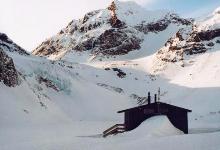 The cabin is beautifully situated, with glaciers dripping off
Klippberget on one side, and soft, snow-covered basins on the other.
I ate my lunch there, hydrated heavily,
and then whizzed back down Tarfalajåkk in a little over an hour.
It was uneven and icy all the way, but must be a very pleasant run in better
conditions, dropping 600m over 5km.
The cabin is beautifully situated, with glaciers dripping off
Klippberget on one side, and soft, snow-covered basins on the other.
I ate my lunch there, hydrated heavily,
and then whizzed back down Tarfalajåkk in a little over an hour.
It was uneven and icy all the way, but must be a very pleasant run in better
conditions, dropping 600m over 5km.
I ate a huge reindeer steak with a glass of red wine in the restaurant
when I got back, and heard that about 20 people had made the south peak
in the perfect weather. If only I hadn't listened to the weather forecast
the day before. But I still had a couple of days to go....
Except the next morning I woke with the backs of both my hands swollen,
and I could hear the tendons squeeking as they moved. So I bandaged them up,
took lots of ibuprofen, and settled in to read Powder magazine and drink tea all day.
The tendons were still squeeking at the end of the week, so the rest of the trip was
abandoned for fear of doing permanent damage. So I still don't really know how it is
to tour on tele skis, but from those 2 days I could see that for a cabin-to-cabin
tour I would choose conventional tour skis with double camber, but I still see the
potential for top tours on tele skis. Maybe next year.
© Mark Harris 1999
(Back to ski report index)
(MRH homepage)

 Ideally, I would have done something gentle this first day, but with the
probability of best visibility being for that day, I decided to climb
Tolpagorni,
the impressive cratered peak that looms behind the fjaellstation. It is 500m
lower than the south peak of Kebnekaise, but still a good climb of 900m from the station.
With few other people around and the dodgy weather, I couldn't count on
having company nearby, and so packed 10kg of emergency overnight kit in case
'something happened'. Snow conditions were odd. There had been little snow all season,
and a thaw, so there was a lot of hard ice and exposed rocks, but a couple of
days previously there had been heavy snow fall and wind, so on lee slopes
the avalanche hazard was high. Any surface snow was soft in the humid mildness.
Ideally, I would have done something gentle this first day, but with the
probability of best visibility being for that day, I decided to climb
Tolpagorni,
the impressive cratered peak that looms behind the fjaellstation. It is 500m
lower than the south peak of Kebnekaise, but still a good climb of 900m from the station.
With few other people around and the dodgy weather, I couldn't count on
having company nearby, and so packed 10kg of emergency overnight kit in case
'something happened'. Snow conditions were odd. There had been little snow all season,
and a thaw, so there was a lot of hard ice and exposed rocks, but a couple of
days previously there had been heavy snow fall and wind, so on lee slopes
the avalanche hazard was high. Any surface snow was soft in the humid mildness.
 To compound the difficulties, I was experimenting with new skis - Tua Cirque,
a go-anywhere tour/telemark hybrid that I had had great success with
on prepared pistes, and now wanted to try on loose snow. But having a
pronounced waist, they were not inclined to track straight, and having no
centre groove, they had a tendency to dive sidways into the snow.
In addition, their soft camber caused them to lose wax quickly and slip backwards.
All this meant that the easy 3km run to the bottom of Kittelbäcken
was much more of a struggle than it should have been, and took about an hour.
I suppose the Tuas are the Landrovers of the skiing world - they will go anywhere,
but if you're on a motorway you'd probably rather be in a Ford.
Once I'd put on my climbing skins, clicked up my Televator heel supports,
and started climbing Kittelbäcken, they were in their element and
I was happy again, and looking forward to coming
back down the loose snow in the ravine. The wind was rapidly picking up,
and by the time I got up to Björling's glacier it was probably around 15 m/s.
Ahead of me I was glad to see two teams headed for the south peak,
a group of 5 Norwegian girls just ahead, and 3 Swedish guys. For a while I considered
following them, but it was my first day touring for a year,
and the weather wasn't good, so I contented myself with my decision to go
left to Tolpagorni at the saddle, rather than going right, up to Vierranvarri
then 500m down and 700m back up to the south peak. And back.
To compound the difficulties, I was experimenting with new skis - Tua Cirque,
a go-anywhere tour/telemark hybrid that I had had great success with
on prepared pistes, and now wanted to try on loose snow. But having a
pronounced waist, they were not inclined to track straight, and having no
centre groove, they had a tendency to dive sidways into the snow.
In addition, their soft camber caused them to lose wax quickly and slip backwards.
All this meant that the easy 3km run to the bottom of Kittelbäcken
was much more of a struggle than it should have been, and took about an hour.
I suppose the Tuas are the Landrovers of the skiing world - they will go anywhere,
but if you're on a motorway you'd probably rather be in a Ford.
Once I'd put on my climbing skins, clicked up my Televator heel supports,
and started climbing Kittelbäcken, they were in their element and
I was happy again, and looking forward to coming
back down the loose snow in the ravine. The wind was rapidly picking up,
and by the time I got up to Björling's glacier it was probably around 15 m/s.
Ahead of me I was glad to see two teams headed for the south peak,
a group of 5 Norwegian girls just ahead, and 3 Swedish guys. For a while I considered
following them, but it was my first day touring for a year,
and the weather wasn't good, so I contented myself with my decision to go
left to Tolpagorni at the saddle, rather than going right, up to Vierranvarri
then 500m down and 700m back up to the south peak. And back.


